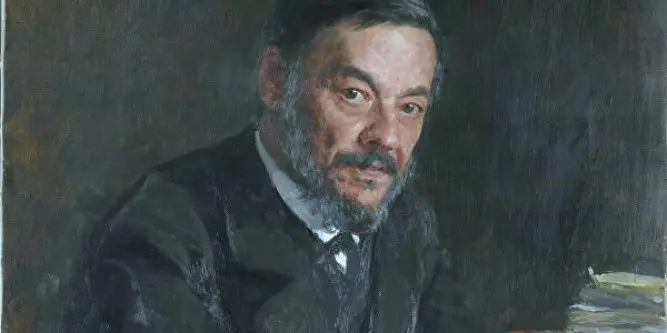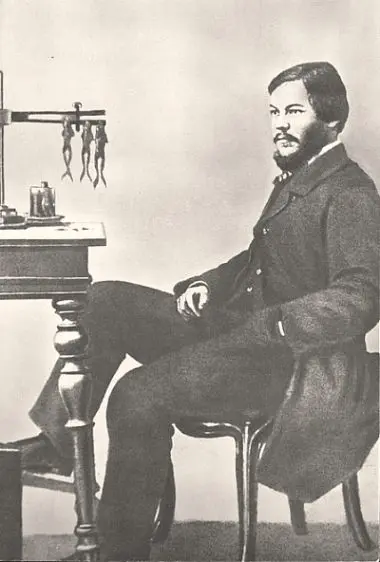Contents

😉 Hello dear readers! Thank you for choosing the article “Sechenov: A Brief Biography of the Famous Physiologist and Educator” on this site. The article will be useful to everyone who studies the history of medicine and is interested in the biography of I.M.Sechenov.
Many do not know that the young Sechenov is the prototype of Kirsanov in Nikolai Chernyshevsky’s novel What Is to Be Done? Ivan Sergeevich Turgenev copied from him the image of Bazarov (“Fathers and Sons”).
Ivan Mikhailovich Sechenov
August 13, 1829 (zodiac sign Leo) in the village of Simbirsk province in a noble family, the eighth child was born, who was named Ivan. His father was a retired military man, he married his own serf, giving her freedom.
Father died when Vanya was ten years old. All children in the family received home education, thanks to the lessons of the governess. Ivan spoke French and German. Fourteen-year-old Ivan Sechenov, at the insistence of his older brother, enters the school of military engineers and leaves for St. Petersburg.
The young man was not fascinated by engineering sciences, but he fell in love with physics and showed an interest in chemistry. After graduating from an engineering school at the age of 19, non-commissioned officer Sechenov was assigned to Kiev, in a reserve engineer battalion. After two years, he resigns with a firm decision to study medicine.
In 1851, having passed the exams brilliantly, the young man became a student at the Imperial Moscow University. While studying theoretical medical subjects, Sechenov became disillusioned with medical science. He is fascinated by lectures on physiology and comparative anatomy. In addition, he is interested in psychology, philosophy and history.
After the death of his mother in 1855, Ivan receives from his brothers 6000 rubles from his mother’s inheritance. This money will be useful for him to improve his education abroad, where he will stay for four years.
Internship abroad (1856-1860)
In 1856 the university graduate went to Berlin. In several laboratories under the supervision of renowned scientists and the Anatomical and Pathological Institute, he conducted research and experiments.
Attended lectures by renowned professors in histology, physiology, comparative anatomy and analytical chemistry. The scientist worked in Leipzig, in Vienna he began work on his doctoral dissertation.
In the spring of 1859 in Heidelberg (Germany), he continued his scientific work on physiological optics and gas analysis. Here he became close to chemists Dmitry Mendeleev and Alexander Borodin, with whom he went to Switzerland in the fall and then to Paris.
Doctor of Medical Sciences I.M. Sechenov
In 1860, Ivan Mikhailovich moved from Paris to St. Petersburg, where he defended his thesis and received the degree of Doctor of Medical Sciences. After a number of discoveries, nine years later, he will be an honorary member of the St. Petersburg Academy of Sciences.
In everyday life, the academician was content with very little and was a modest person. In 1901, the doctor of medicine retired, four years later he died of pneumonia. He bequeathed most of his fortune to the simple peasants of his native village.
His name was given to the First Moscow Medical Academy, the Institute of Evolutionary Physiology and Biochemistry of the Russian Academy of Sciences. A crater on the far side of the moon was named after him. The Academy of Sciences established the V.I. Sechenov, awarded for outstanding research in physiology.
Personal life
The wife of Ivan Mikhailovich was M.A. Bokova (nee Obrucheva). Maria Alexandrovna is one of the first Russian women doctors, doctor of medicine. She studied in St. Petersburg, was a student of Sechenov, worked in his laboratory.
Voluntarily worked as a sister of mercy during the Franco-Prussian War (1870-1871). Is the prototype of Vera Pavlovna in Chernyshevsky’s novel “What is to be done?”
Sechenov: contribution to science
- is the founder of the physiological school, which he formed by 1868.
- introduced into the practice of conducting lectures with demonstration of experiments;
- developed the concept of non-specific brain systems;
- discovered the fundamental physiological phenomena of the central nervous system;
- in his work “Reflexes of the Brain” (1866), he substantiated the reflex nature of conscious and unconscious activity;
- scientifically proved that the duration of the working day should not exceed eight hours;
- his works on the physiology of blood respiration, gas exchange, and the dissolution of gases in liquids laid the foundations of aviation and space physiology;
- was the first to conduct fundamental research on the effects of alcohol on the body;
- is one of the founders of electrophysiology;
- The scientist devoted a lot of time and effort to creating a system of higher education for women.
Do not miss the video, there are many facts from the life of a scientist. Additionally on the topic “Ivan Sechenov: a short biography”
😉 Friends, was this information helpful to you? Leave in the comments additions on this topic. Subscribe to the newsletter of new articles to your e-mail. mail. Fill out the simple form at the top: name and email.










Πολύ καλό άρθρο. Παρακαλώ να δημιουργήσετε ένα άρθρο βιογραφίας στην Ελληνική Wikipedia. Δρ. Χαράλαμπος Γκούβας, Μουσείο Τεχνών και Επιστημών Ηπείρου